Aircraft manufacturer and defense contractractor Boeing Company (NYSE:BA) of Chicago, IL, was the world’s largest aircraft maker as of January 2014 beating out its rival corporation Airbus Group (EPA:AIR) in terms of new aircraft orders. One nation which has been attracting a lot of Boeing’s attention is China. The corporation just announced its first foreign production facility, a completion plant for its popular 737 twinjet airliner to be built in China, timed to coincide with a tour of Boeing’s facilities in Everett, WA, by Chinese President Xi Jinping; the company also received orders for 300 new aircraft from three Chinese companies. Boeing executives have already cited the languishing charter of the Export-Import Bank as a potential impetus for moving American jobs to foreign shores. Boeing’s involvement in the Chinese market goes back more than 40 years and as of July 2015, Boeing airliners made up about half of China’s commercial airliner market.
The Ex-Im Bank’s reauthorization issues haven’t completely ruined Boeing’s foreign business since India’s government recently authorized as much as $3 billion to purchase 37 Boeing military helicopters. Domestically, Boeing recently secured an order from FedEx Corporation (NYSE:FDX) for 50 new Boeing 767 freighter aircraft to replace inefficient freighters in its current fleet. A modified 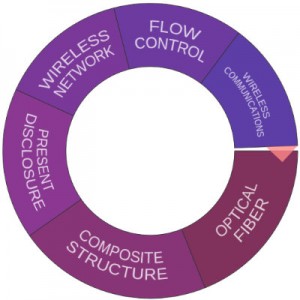 version of the 767 being developed for military applications, the KC-46, is about to undergo four months of testing its aircraft refueling systems for Pentagon approval.
version of the 767 being developed for military applications, the KC-46, is about to undergo four months of testing its aircraft refueling systems for Pentagon approval.
Boeing is a pretty frequent petitioner for patents at the U.S. Patent and Trademark Office. In 2014, the company ranked 45th overall with a total of 911 U.S. patents which it had earned throughout that year, an increase of almost 15 percent more than Boeing’s 2013 patent totals. Over the past three months, Boeing has received 252 U.S. patents, a quarterly pace of innovation that would best last year’s results if maintained throughout the year. The text cluster here, provided by the analytical tools available through Innography, shows us that wireless communications and optical fiber tech have been areas of recent R&D focus at Boeing.
[Companies-1]
Boeing’s Issued Patents: From Drones for Forestry Management to Fuel Cell Water Generation
Developing safer fuel systems for aircraft manufactured by Boeing led to the invention protected by U.S. Patent No. 9114886, titled Method and System for Reducing the Flammability of Fuel-Tanks Onboard an Aircraft. This patent protects a fuel vapor removal method for an aircraft by removing an ullage mixture with a certain fuel-air ratio from ullage of an aircraft’s fuel tank, exposing the ullage mixture to an adsorption media of an aircraft’s adsorber to produce a reduced fuel-air ratio ullage mixture and reducing the reduced fuel-air ratio ullage mixture to the fuel tank. This innovation was pursued to address increased Federal Aviation Administration regulations regarding enhanced safety measures against fires or explosions in fuel tank ullage, or the empty space in 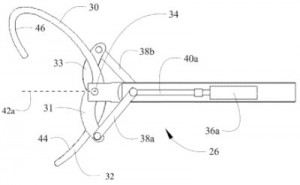 the fuel tank above the fuel. Boeing has increased its unmanned aircraft tech holdings with the issue of U.S. Patent No. 9132916, which is titled Aircraft Deployment and Retrieval of Unmanned Aerial Vehicles. The aircraft system disclosed here includes a first aircraft having a grappling device with two grippers attached to different actuators and moving about a common pivot to engage a hooking device, as well as a first controller configured to receive a command for operating the actuators to provide grappling at a range of capture angles. This innovation, developed primarily for combat and surveillance drones, enables drones to be deployed at a further distance from its target to improve mission crew safety. Unmanned aerial vehicles (UAVs) are also featured within U.S.
the fuel tank above the fuel. Boeing has increased its unmanned aircraft tech holdings with the issue of U.S. Patent No. 9132916, which is titled Aircraft Deployment and Retrieval of Unmanned Aerial Vehicles. The aircraft system disclosed here includes a first aircraft having a grappling device with two grippers attached to different actuators and moving about a common pivot to engage a hooking device, as well as a first controller configured to receive a command for operating the actuators to provide grappling at a range of capture angles. This innovation, developed primarily for combat and surveillance drones, enables drones to be deployed at a further distance from its target to improve mission crew safety. Unmanned aerial vehicles (UAVs) are also featured within U.S. 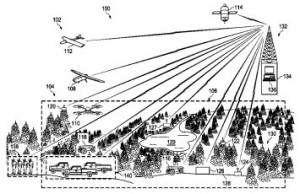 Patent No. 9117185, issued under the title Forestry Management System. The forestry management system claimed here involves a computer system and a forestry manager in the computer system configured to receive information about a forest from a group autonomous vehicles, analyze the information to generate a result about the forest’s state and coordination operation of the group of autonomous vehicles to perform information collection about forest health and forest inventory. This innovation provides a more accurate and uniform technique for collecting forestry information than conventional methods using human operators.
Patent No. 9117185, issued under the title Forestry Management System. The forestry management system claimed here involves a computer system and a forestry manager in the computer system configured to receive information about a forest from a group autonomous vehicles, analyze the information to generate a result about the forest’s state and coordination operation of the group of autonomous vehicles to perform information collection about forest health and forest inventory. This innovation provides a more accurate and uniform technique for collecting forestry information than conventional methods using human operators.
An intriguing nanotechnology for improving heat management techniques utilized within electronics is at the center of U.S. Patent No. 9095941, which is titled Graphene Nanoplatelet Metal Matrix. The method of forming a graphene metal matrix composite protected here involves providing first graphene nanoplatelets with a thickness less than 100 nanometers (nm), forming a first substantially uniformly oriented graphene layer in which the graphene nanoplatelets are oriented in a first direction, disposing the first graphene layer in a metal matrix to form a first graphene metal matrix composite layer, providing second graphene nanoplatelets of the same thickness, forming a second graphene layer comprised of graphene nanoplatelets oriented in a second direction, disposing the second graphene layer in the metal matrix to form a second graphene metal matrix composite layer and stacking the graphene metal matrix composite layers to form the graphene metal matrix composite. The graphene nanoplatelet technology in use for this innovation provides a metal matrix composite (MMC) for high-power electronic packaging which has improved thermal management compared to conventional graphite or carbon nanotube MMCs.
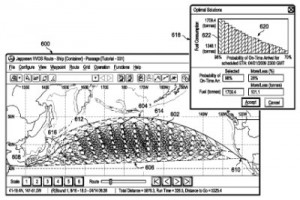 The commercial transport of freight on cargo ships is an area of Boeing R&D that is reflected by U.S. Patent No. 9109895, which is titled Estimating Probabilities of Arrival Times for Voyages. The method for generating a route for a ship claimed here involves identifying a start point and an end point for travel by sea and a period of time for traveling between the two points, generating a sea route between the start and end points, dividing the sea route into a plurality of segments, calculating a segment probability for ship travel at a desired speed for each segment using both navigation and forecasting information, multiplying the plurality of segment probabilities to form a route probability for the ship reaching the end point within a period of time, generating a graphical display displaying a plurality of route probabilities of the ship reaching the end point and selecting a route having an acceptable probability of the ship reaching the end point within a period of time. This system is designed to enable commercial shipping operators to better adjust a route in response to a change in weather conditions.
The commercial transport of freight on cargo ships is an area of Boeing R&D that is reflected by U.S. Patent No. 9109895, which is titled Estimating Probabilities of Arrival Times for Voyages. The method for generating a route for a ship claimed here involves identifying a start point and an end point for travel by sea and a period of time for traveling between the two points, generating a sea route between the start and end points, dividing the sea route into a plurality of segments, calculating a segment probability for ship travel at a desired speed for each segment using both navigation and forecasting information, multiplying the plurality of segment probabilities to form a route probability for the ship reaching the end point within a period of time, generating a graphical display displaying a plurality of route probabilities of the ship reaching the end point and selecting a route having an acceptable probability of the ship reaching the end point within a period of time. This system is designed to enable commercial shipping operators to better adjust a route in response to a change in weather conditions.
Water collection systems for serving public water utilities doesn’t seem that it would be the domain of Boeing but it is the focus of U.S. Patent No. 9088018, issued under the title Water Harvesting System. This patent protects a water extraction system which includes a fuel cell system that generates power as well as a number of fluids in response to generating power, a cooling device connected to and powered by the fuel cell systems having one heated side for turning water into vapor and one cooling side, a number of tubes connected to the cooling device’s heating side and thermally connected to the cooling side, a collection system that collects water vapor generated by heating water vapor materials, a radiator system connected to the fuel cell system and the collection system to transfer heat from the water vapor to an environment around the radiator, an output system connected to the radiator system and directing water vapor to the cooling side of the cooling device and a controller controlling the power delivered to the cooling device and the radiator system. This fuel cell system is designed for the generation of water for human and/or industrial use in areas where rainfall or groundwater systems are scarce.
[Companies-3]
Patent Applications of Note: From Spacecraft Innovations to Electricity Generation Systems
Aerospace technologies which will improve the operation of spacecraft were featured within a trio of Boeing patent applications that we noted in our most recent survey, including U.S. Patent Application No. 20150240132, entitled Thermally Conductive Flexible Adhesive for Aerospace Applications. The patent application would protect a method for forming a thermally conductive flexible bond for use in an electronic board by providing adhesive components comprised of boron nitride particles having surface organofunctional groups, forming an adhesive material from the adhesive components, applying the adhesive material to the electronic board’s surface, forming a contact between an electronic component and the adhesive material and curing the adhesive material to form a cured adhesive structure between the electronic board and the electronic component. This adhesive material provides better thermal management of electronic components for unmanned space missions, which is necessary for miniaturized semiconductors which 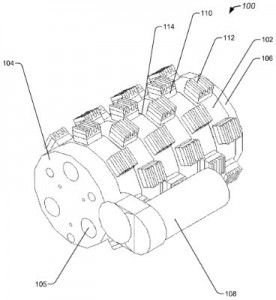 generate more heat. Food preparation in zero-gravity environments is discussed within U.S. Patent Application No. 20150230664, which is titled Multifunction Programmable Foodstuff Preparation. The device for preparing food claimed here has a container including a cavity that stores at least one food ingredient, a plate connected to an end of the container and having a hole for receiving the food ingredient, a second plate connected to a second end of the container, a mixing device that mixes food ingredients in the container’s cavity and a heat transfer device coupled to the container for exchanging heat with the interior of the container. This innovation provides a much simpler configuration for preparing and heating food for use in outer space. Better protection for spacecraft from the particles and materials which could collide with it at high speeds in outer space is afforded by the invention described within U.S. Patent Application No. 20150259081, which is titled Integrated Armor for Hypervelocity Impacts. It claims a structural armor for a space structure which has a front armor facesheet, a rear armor facesheet offset from the front armor facesheet and an angular member core having a plurality of nodes, each of which abuts either the front or the rear armor facesheet and providing a junction for a plurality of angular members intersecting at an acute node angle from either armor facesheet; the acute node angle utilized is selected according to a spread angle of a debris field resulting from a hypervelocity impact of an object with the front armor facesheet. This innovation is intended to provide both protection for a spacecraft as well as load-bearing capabilities for the spacecraft’s structure.
generate more heat. Food preparation in zero-gravity environments is discussed within U.S. Patent Application No. 20150230664, which is titled Multifunction Programmable Foodstuff Preparation. The device for preparing food claimed here has a container including a cavity that stores at least one food ingredient, a plate connected to an end of the container and having a hole for receiving the food ingredient, a second plate connected to a second end of the container, a mixing device that mixes food ingredients in the container’s cavity and a heat transfer device coupled to the container for exchanging heat with the interior of the container. This innovation provides a much simpler configuration for preparing and heating food for use in outer space. Better protection for spacecraft from the particles and materials which could collide with it at high speeds in outer space is afforded by the invention described within U.S. Patent Application No. 20150259081, which is titled Integrated Armor for Hypervelocity Impacts. It claims a structural armor for a space structure which has a front armor facesheet, a rear armor facesheet offset from the front armor facesheet and an angular member core having a plurality of nodes, each of which abuts either the front or the rear armor facesheet and providing a junction for a plurality of angular members intersecting at an acute node angle from either armor facesheet; the acute node angle utilized is selected according to a spread angle of a debris field resulting from a hypervelocity impact of an object with the front armor facesheet. This innovation is intended to provide both protection for a spacecraft as well as load-bearing capabilities for the spacecraft’s structure.
In addition to its focus on developing unmanned aircraft systems, Boeing has also pursued R&D in unmanned underwater vehicles as readers can see within U.S. Patent Application No. 20150251741, entitled Autonomous Power Generation in Submersible Environments. The apparatus disclosed here includes a generator having a combustion air intake port and a combustion exhaust port, a water-tight enclosure surrounding the generator, an intake valve coupling the air intake port to an enclosure’s outside surface to transport air from the outside surface to the air intake port when the port is open, an exhaust valve coupling the exhaust port to the enclosure’s outside surface and transporting exhaust when the exhaust port is open and a controller which determines that the enclosure will submerge to stop the generator and close the valves; upon resurfacing, the controller starts the generator and opens the valves. This system enables the production of power for autonomous underwater vehicles through the combustion of diesel fuel, which requires the intake of oxygen and the discharge of gases. A novel system for the generation of electricity is also featured within U.S. 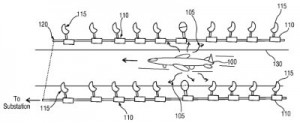 Patent Application No. 20150260171, which is titled Method and System for Producing Electricity from Airport Acoustical Energy. The system for generating electricity from acoustic energy claimed here includes an acoustic wave collector that collects acoustic energy and directs that energy in a predetermined direction, an acoustic converter assembly positioned to receive the acoustic energy from the acoustic wave collector and converting the received acoustic energy into an output airflow having a magnitude proportional to a magnitude of the acoustic energy, a turbine assembly that receives the output airflow to rotate a shaft and a generator coupled to the shaft which generates electricity proportional to the rate of the shaft’s rotation. This system is designed to recycle the acoustic energy generated during takeoffs and landings of aircraft at airport runways.
Patent Application No. 20150260171, which is titled Method and System for Producing Electricity from Airport Acoustical Energy. The system for generating electricity from acoustic energy claimed here includes an acoustic wave collector that collects acoustic energy and directs that energy in a predetermined direction, an acoustic converter assembly positioned to receive the acoustic energy from the acoustic wave collector and converting the received acoustic energy into an output airflow having a magnitude proportional to a magnitude of the acoustic energy, a turbine assembly that receives the output airflow to rotate a shaft and a generator coupled to the shaft which generates electricity proportional to the rate of the shaft’s rotation. This system is designed to recycle the acoustic energy generated during takeoffs and landings of aircraft at airport runways.
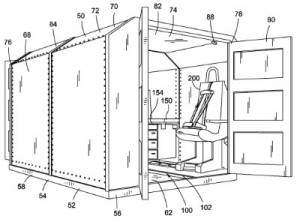 The transport of wounded combat personnel is a concern addressed by the technology that would be protected by U.S. Patent Application No. 20150209203, which is titled Method of Transporting a Patient. The method of transporting a patient disclosed here involves providing a medical pad having a pallet with a floor structure and side walls extending upwardly from the pallet to a roof section, coupling a patient restraint system to the floor structure using a transport system located on the floor structure and moving the patient restraint system from a first position to a second position. This patient transport system provides an arrangement which can be well lit and optimized for examining and treating a patient during transport.
The transport of wounded combat personnel is a concern addressed by the technology that would be protected by U.S. Patent Application No. 20150209203, which is titled Method of Transporting a Patient. The method of transporting a patient disclosed here involves providing a medical pad having a pallet with a floor structure and side walls extending upwardly from the pallet to a roof section, coupling a patient restraint system to the floor structure using a transport system located on the floor structure and moving the patient restraint system from a first position to a second position. This patient transport system provides an arrangement which can be well lit and optimized for examining and treating a patient during transport.
Finally, we were interested in an innovation for optimizing aircraft space in regards to waste disposal, reflected within U.S. Patent Application No. 20150203203, which is titled Waste Disposal System for Aircraft. The apparatus claimed here includes a receptacle system configured to hold waste and located in a space between a galley and a bulkhead of an aircraft. This innovation addresses various shortcomings in conventional waste management systems on aircraft, which can be inaccessible during flight and require excessive time for sorting and transferring waste between flights.

![[IPWatchdog Logo]](https://ipwatchdog.com/wp-content/themes/IPWatchdog%20-%202023/assets/images/temp/logo-small@2x.png)

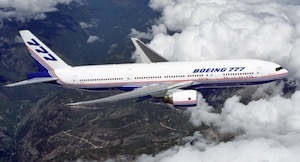

![[Advertisement]](https://ipwatchdog.com/wp-content/uploads/2024/04/UnitedLex-May-2-2024-sidebar-700x500-1.jpg)
![[Advertisement]](https://ipwatchdog.com/wp-content/uploads/2024/04/Artificial-Intelligence-2024-REPLAY-sidebar-700x500-corrected.jpg)
![[Advertisement]](https://ipwatchdog.com/wp-content/uploads/2024/04/Patent-Litigation-Masters-2024-sidebar-700x500-1.jpg)

![[Advertisement]](https://ipwatchdog.com/wp-content/uploads/2021/12/WEBINAR-336-x-280-px.png)
![[Advertisement]](https://ipwatchdog.com/wp-content/uploads/2021/12/2021-Patent-Practice-on-Demand-recorded-Feb-2021-336-x-280.jpg)
![[Advertisement]](https://ipwatchdog.com/wp-content/uploads/2021/12/Ad-4-The-Invent-Patent-System™.png)






Join the Discussion
No comments yet.